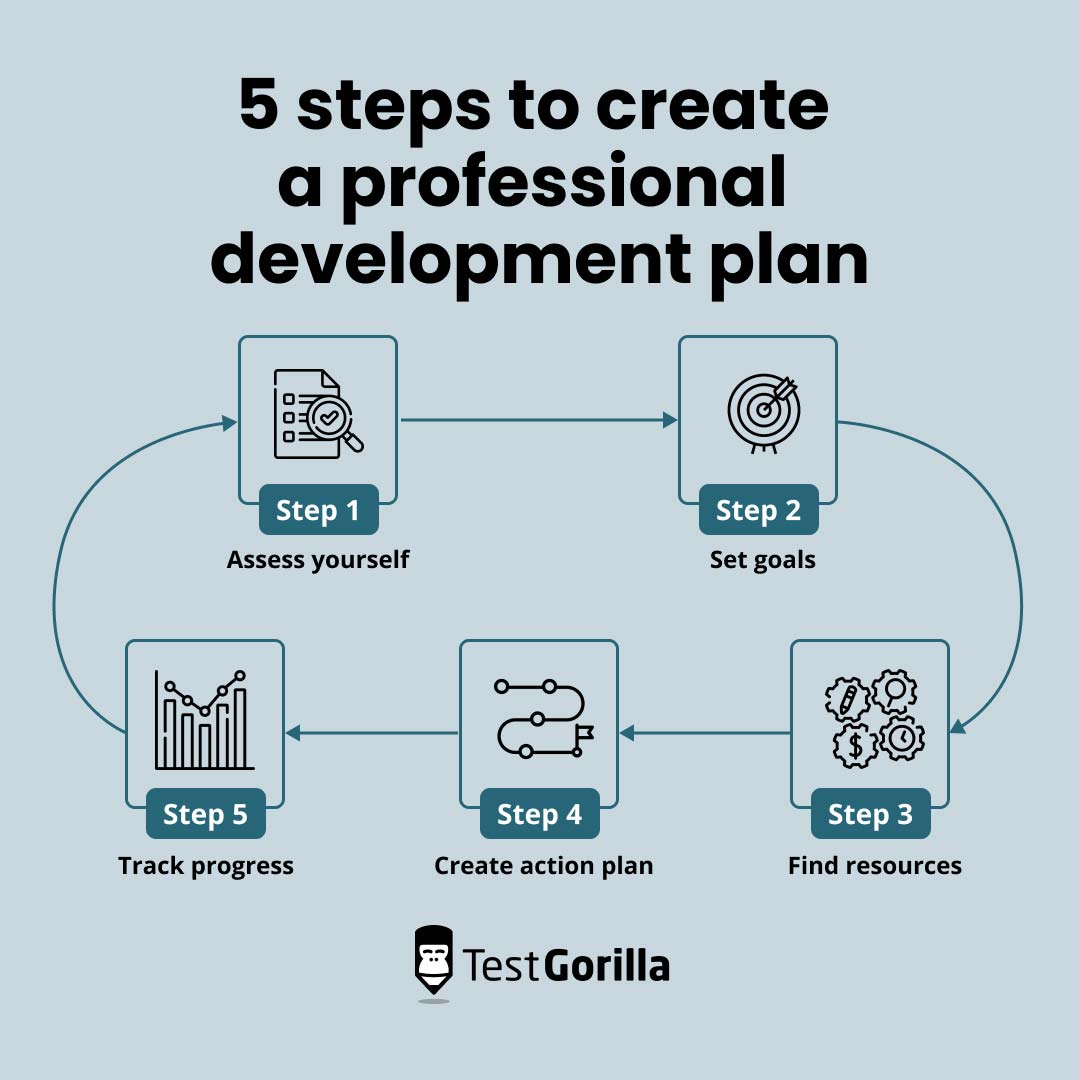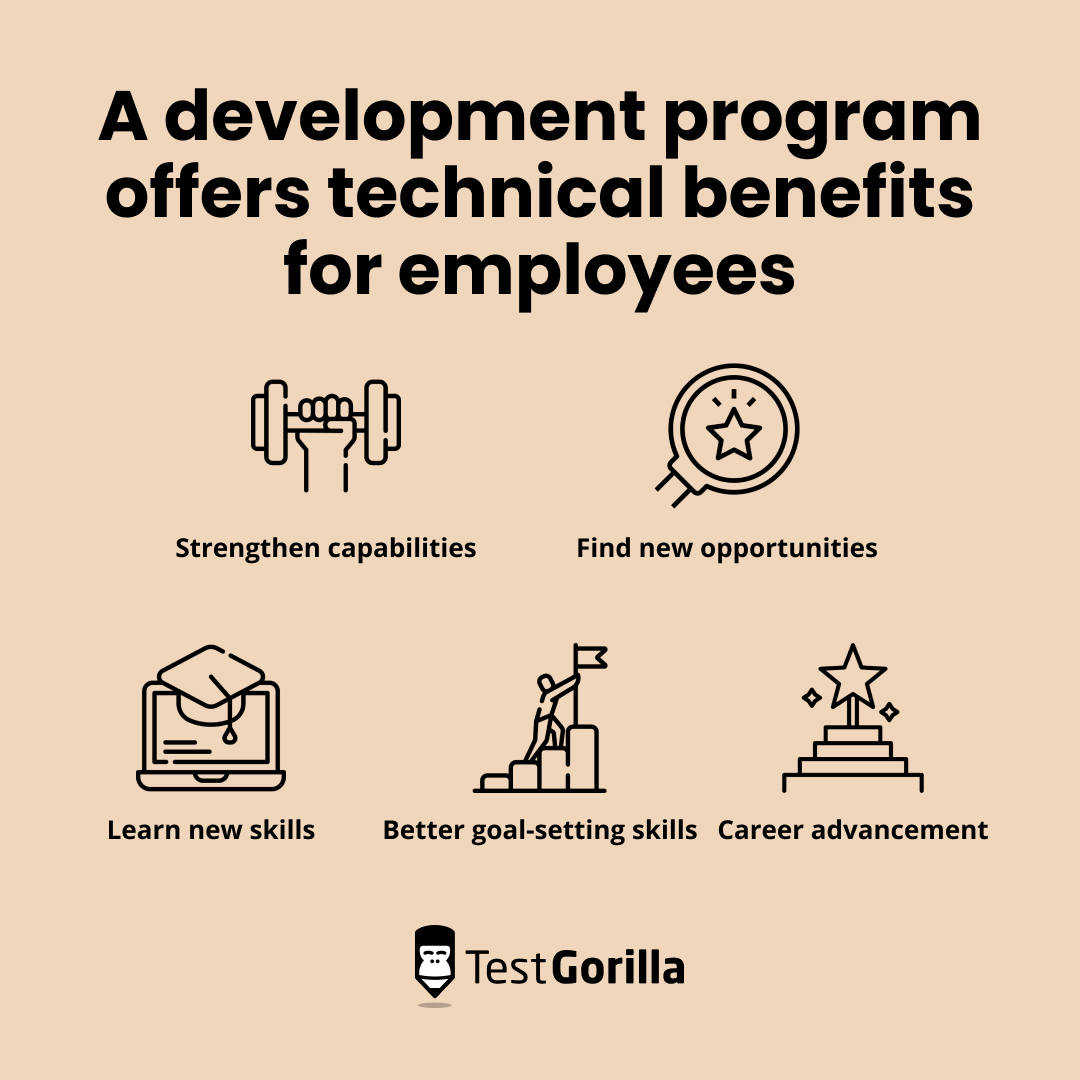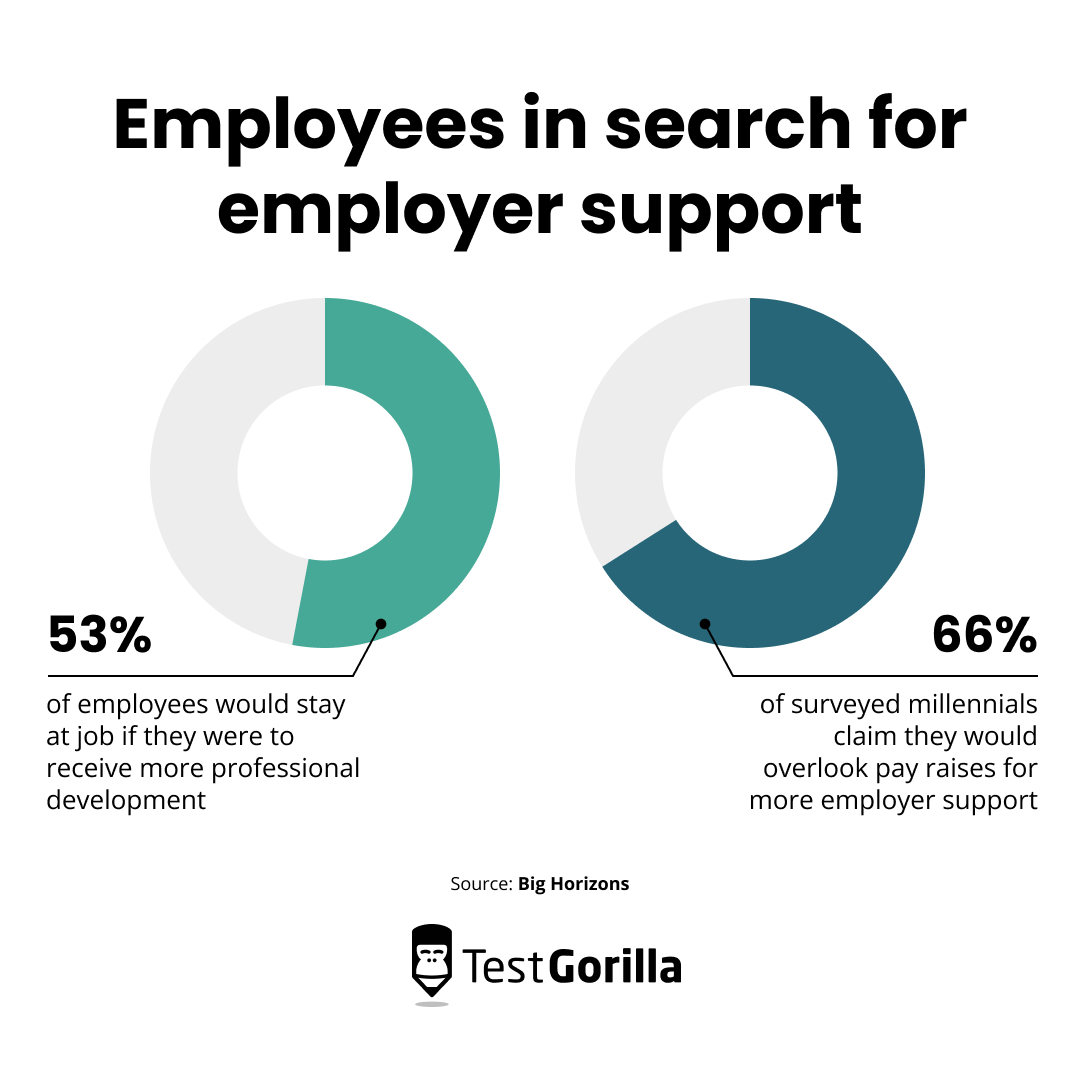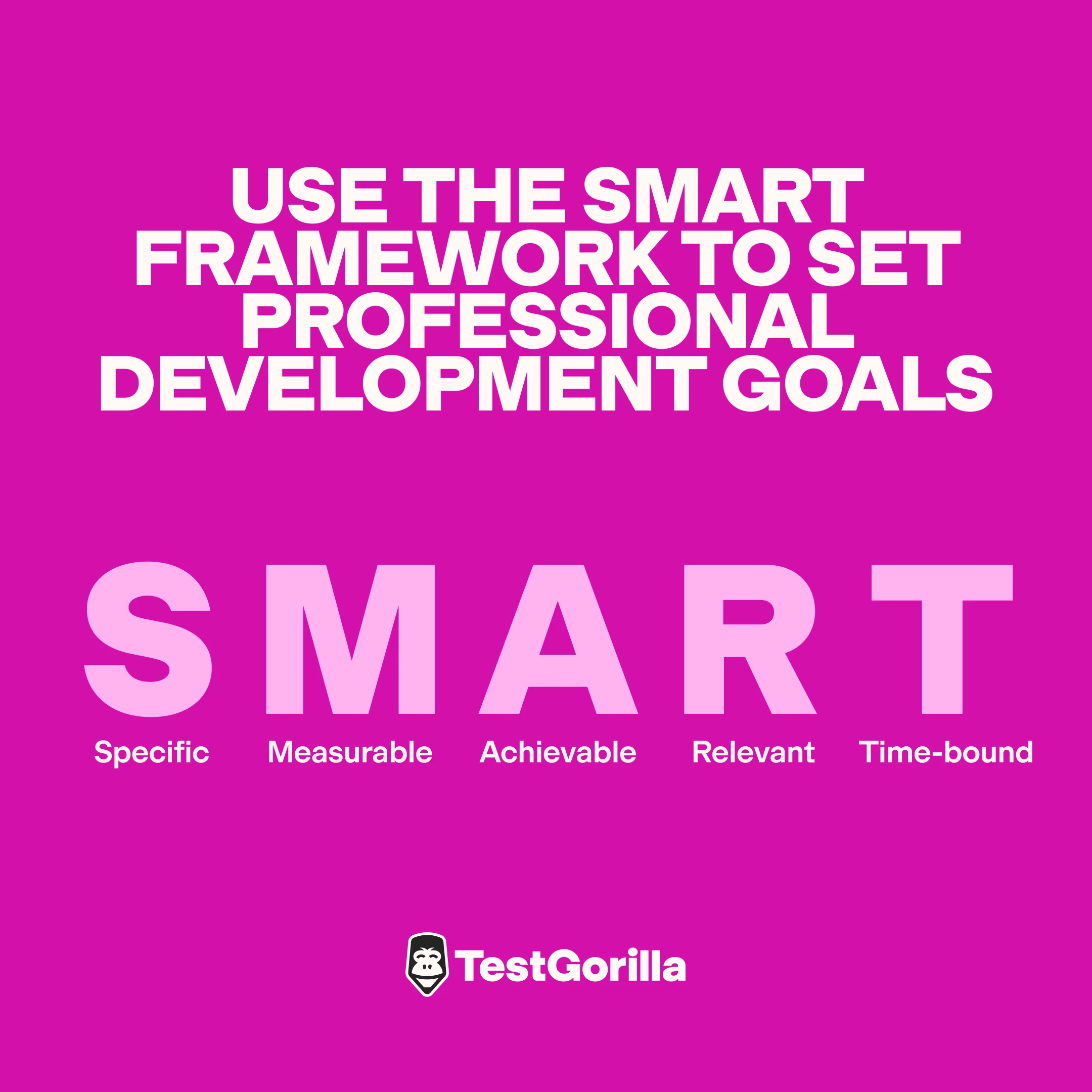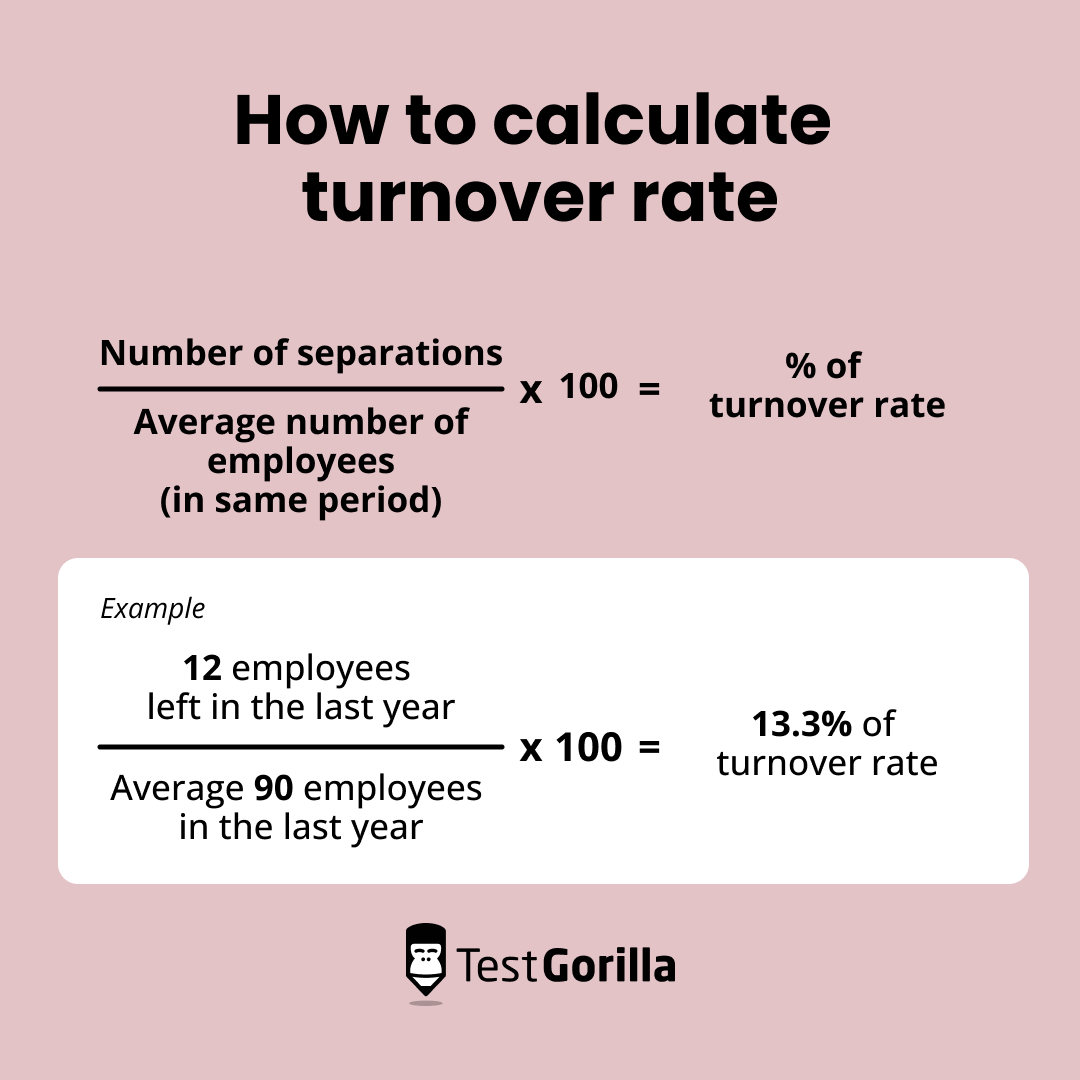Professional development plans: How to leverage this talent retention strategy and support loyal employees
You need more than competitive salaries to win your employees’ loyalty.
Up to 94% of workers stay longer with companies that invest in their learning and development and support their career growth.[1]
And 45% of workers leave organizations searching for better professional development.[2]
If your employees feel they’re purely filling seats, it’s only a matter of time before they go elsewhere – so you need a plan to support their professional growth and development.
That’s where professional development plans come in.
When you invest in your workers with employee development plans, you:
Find career opportunities for talented workers in-house
Retain engaged and motivated workers
Boost team morale, productivity, and job satisfaction
In this guide, we show you why in-house development is a top employee retention strategy – and if you want to get straight to our tips, please jump ahead using the table of contents below.
Table of contents
- What is a professional development plan?
- Why are professional development plans important?
- The benefits of employee professional development plans
- 8 best practices for leveraging professional development plans to retain your best performers
- 3 examples of companies succeeding with professional development plans as a talent retention strategy
- Retain top talent with a professional development plan
What is a professional development plan?
A professional development plan, or PDP, is a document that sets an employee's career goals and how you intend to help them meet them.
Professional development planning identifies an employee’s long-term goals while breaking down the skills they need to reach them.
As the employer, you contribute by providing resources, such as learning and development programs, mentoring, and peer group support.
Beyond this, a professional development growth plan breaks down a tangible route for employees to reach their full potential. HR managers frequently use them alongside talent retention trends that focus on skill development, such as job rotation programs.
For example, if a junior copywriter shows an interest in moving from their current position to being a search engine optimization (SEO) lead, you could find opportunities for them to shadow experts in your company and offer chances for them to practice on live campaigns, gradually upskilling them.
Plans vary from industry to industry; an IT professional development plan differs greatly from one designed for online marketers.
However, they typically break down into four or five action steps:
PDPs give employees relevant professional development opportunities in-house, removing their need to switch companies for their career path.
Once you start using professional plans, be careful not to confuse them with personal development plans, which sometimes use the same acronym, PDP.
Personal development focuses on non-professional goals, like emotional and social wellbeing.
Professional development plans vs. leadership development plans
Leadership development plans focus on nurturing people management skills. They're separate from PDPs because they often follow a specific roadmap into supervisory roles.
A leadership development plan might give people specific opportunities to mentor others, take charge of projects, and use people management skills tests to track progress.
Why are professional development plans important?
Learning and development are among the best employee benefits to attract long-term personnel.
Workers are 12 times more likely to look for external opportunities if they don't believe their employers can support their career goals. For new recruits, that leaps to 30 times.[3]
Moreover, 70% of US workers consider it "somewhat likely" they'd leave a company for more learning and development investment elsewhere.[4]
PDPs satisfy existing hires and attract highly skilled recruits, and upskilling and reskilling your workforce ensures it’s more capable, talented, and efficient.
A more talented workforce is a more agile workforce. It's easier for you to move talent around your company if people are multi-skilled and your people benefit from fulfilling new opportunities.
With this, there are likely to be more internal mobility opportunities across your company for your staff.
This agility helps employees react better to change, too. You're developing a learning culture, meaning your organization becomes adaptable, especially if you focus on gaining new skills.
That said, for workers, the biggest benefit of a professional development growth plan is getting to see tangible steps toward their goals.
Documenting steps and resources helps make goals appear more achievable, boosting confidence and increasing engagement at work.
PDPs show employees that personal development is important and helps strengthen their capabilities.
Your workers see businesses value them as individuals, not as seat fillers. It's a boost for employee recognition, self-worth, and confidence.
That’s all without mentioning the technical benefits for employees:
The best insights on HR and recruitment, delivered to your inbox.
Biweekly updates. No spam. Unsubscribe any time.
The benefits of employee professional development plans
For employers and HR, the most important benefits of professional development planning are that:
You retain more employees
Efficiency and productivity increase
You attract top talent
Let’s break down these advantages and show you how PDPs directly benefit your company and workforce.
1. You retain more employees
People stay with companies that value them.
Look at the stats:
82% of employees say it’s important to feel valued by a company
Yet only 45% of them think companies do enough
77% of people believe they're on their own regarding career development.[4]
Creating an employee development plan shows your team this isn't the case and that you want to help them reach their goals in-house.
You’re capturing the interest of 53% of people who say they'd stay at a job purely if they were to receive more professional development and the 66% of surveyed millennials who claim they'd overlook pay raises for more support.[5]
When you give opportunities for people to develop, there’s less chance of them looking elsewhere for it.
2. Succession planning is easier
Succession planning involves preparing your pipeline for recruitment gaps and challenges that arise when someone retires or leaves your company (often unexpectedly).
Essentially, you ensure there’s always talent onboard that can take over if someone quits or if there’s a shortage of support.
Research shows 79% of the world’s best-performing companies use succession plans – it’s a lead worth following.[6]
PDPs help you plan for role succession because you know who's developing which skills and toward which goals. You're more aware of your workforce's agility.
Organizing efficiently, you ensure there’s always someone waiting to step in to take up responsibilities elsewhere in the business.
Using skills testing as part of your PDP process reduces the need to hire externally by accurately moving the right people into the best roles for their talents and career desires.
3. Efficiency and productivity increase
Employees who learn skills and feel they're working toward goals are more likely to feel engaged at work.
Up to 42% of employers in India note employee performance and productivity boosts after learning and development initiatives.
Employees agree, too. Another survey shows that 80% of people believe dedicated training benefits their productivity.[7]
Professional development helps people widen their skill sets and thus embrace innovation.
Moreover, PDPs help motivate people by giving them extra confidence. They're not just working as a means to an end; they're actively working toward goals that fulfill them.
4. You attract top talent
An added bonus to PDPs is they attract highly talented candidates.
Up to 65% of job seekers see upskilling opportunities as an important factor when assessing roles to apply for.
Leaning into capability building, too, ensures you attract people passionate about their own professional development. You’re appealing to people who want to upskill and develop, not simply pick up a paycheck.
While retaining existing top performers, you're also hiring the right people who are most receptive to your PDP strategies – provided you make your intentions clear in your recruitment marketing and job descriptions.
8 best practices for leveraging professional development plans to retain your best performers
Now that we’re clear on how PDPs benefit organizations and workers alike, here are eight ways you can use them as a talent retention strategy.
How to create a professional development plan: 8 proven practices to try
Best practice | Quick summary |
1. Bring up PDPs early in employee journeys | Promote development plans and inspire recruits to stay with you to achieve their goals, while improving employer branding |
2. Evaluate employees with talent assessments | Test people to learn more about where they could travel in your business and what motivates them |
3. Narrow down skills for each role | Show employees what to expect to encourage their participation and help them hit goals faster |
4. Help people set realistic goals | Use SMART goal setting and skills test results to create milestones that are achievable and inspiring |
5. Check in regularly | Meet with workers to assure them you care about their progress, to keep them accountable, and to foster transparency |
6. Provide employees and managers with a range of resources | Show workers growth opportunities available to them to inspire action and confidence, and create remote resources to keep processes inclusive |
7. Use PDP templates and record progress | Develop action plans to help people stay on target and ensure managers learn PDP processes fast |
8. Use data to measure progress and PDP effectiveness | Check objective data – such as retention and tenure stats – to influence your future development planning |
1. Bring up PDPs early in employee journeys
A study undertaken by Aerotek finds that 90% of people value skill development opportunities when looking for work, and 11.3% claim they value professional development as the most important factor when deciding on a new job.
Therefore, it makes sense to show recruits you care about their learning and development as early as possible when bringing them on board.
You’re not only attracting people who value development – you’re keeping their interest by making a promise and following through.
So, make your position on personal development clear in your job descriptions and follow through on your promises during the onboarding process. This strategy gives a good first impression of your company and encourages retention.
Starting professional development as early as possible further helps you and your team members get a firmer grip on what they'd like to do and how you can support them over time.
It’s a good boost for your employer branding, too. Positive word travels fast across professional networks and social media.
2. Evaluate employees with talent assessments
Talent assessment tests help you understand your employees’ strengths and weaknesses. It’s objective data you can use to help write and develop their PDPs.
Moving toward a culture of talent assessments benefits your overall retention chances, too. TestGorilla’s State of Skills-Based Hiring report found that 91% of companies improved employee retention when they switched to skills-based hiring.
Test recruits' current skills and personality traits to better understand how they can grow and develop within your company.
Test for power skills, such as critical thinking and problem-solving, and consider where these traits are most useful within your business.
Here’s an example of an introductory assessment you could use to review an administrative assistant. The assessment includes tests for three technical skills and two transferable power skills:
Once the employee completes the tests, use the data to suggest potential opportunities to them while tying closely to their goals.
Above all, use skills tests to list employee strengths and rank scores in areas they wish to develop to show where training and support are needed.
Finally, consider using self-assessments to understand how people view themselves and where they're heading.
Doing so gives you insight into what drives people and how to tailor support options through their PDPs.
3. Narrow down skills for each role
Start preparing your PDPs by breaking down the roles in your business into specific skills.
Only 60% of people say they have clear expectations about their roles and what they entail. The remaining 40% of employees need you to be more explicit about what they could achieve – and a clear, concise PDP is a good place to start.[8]
Start by creating "baseline skills" for each role so people know what you expect of them. Doing so keeps the process transparent and gets your staff up to speed.
Then test your broader workforce to find skill correlations. For instance, are the marketing leaders in your company expert communicators? Do they all score highly in using specific software like Adobe InDesign?
Once you're clear on your best-performing employees' skills, test your newest recruits and find ways to improve their aptitude.
From there, use this data to plan where to move people with clear aptitude. For example, if a junior financier shows expertise in GAAP accounting, you can confidently start to move them into a more senior position.
4. Help people set realistic goals
Help employees be realistic about their goals by creating a timeframe. Recommend short-, mid-, and long-term goals.
As per our previous two points above, you could use the data collected from skills tests to better understand your team members’ strengths and weaknesses.
Let's say a specific employee scores highly in working with generative AI. You expect them to reach their AI-related goals faster than someone with lower scores, so you set more realistic, achievable, and easily visualized targets.
Realistic timeframes help you to organize support along the way, too. For example, you could set mentoring as a short-term goal and hands-on project management as a long-term goal.
Try to link any professional development ideas you have in mind, such as upskilling and promoting workers and encouraging employee training programs.
Consider using the SMART approach during planning to help people set goals that are measurable and time-bound:
Studies show visualizing your goals doubles your confidence in reaching them. By setting realistic targets, you support your employees and stand to double their enthusiasm and productivity, too.[9]
5. Check in regularly
You should always schedule performance review one on one meetings with workers to show you care and to ensure they're on target.
Research suggests that 65% of people reach their goals if they have accountability partners to back them up. By checking in regularly with your employees, you’re that partner.[10]
Start by communicating clearly. Always ask workers how they’re progressing, and don’t make assumptions. Are there any ways you could provide extra support? Do they feel confident, comfortable, and productive?
Asking for employee feedback on individual PDPs shows you invest in what they say and how they feel. You make the process more personal and show you're not an employer who "always knows best."
This attitude helps people feel more valued, and they're more likely to stay with you.
What’s more, encouraging upward feedback, where employees discuss how managers are handling their development, further helps keep the process as supportive and transparent as possible.
6. Provide employees and managers with a range of resources
Be sure to offer the full range of resources and support options you have available via PDPs. Don’t assume the same one or two resources support everyone in the same way.
Familiarize your managers with resources they can recommend to their teams. These might include mentorships, buddy programs, in-house seminars, paid work experience, and online modules.
This clarity shows employees what's possible in your organization. Some people might hesitate to acknowledge their dreams because they don't know what tools and resources are available.
In fact, 80% of people don’t feel their employers offer growth opportunities period. Now's a good opportunity to buck the trend and show people what's available, building their confidence and self-motivation.[11]
On top of this, keep your resources inclusive for people working offsite as part of a remote work policy. Tailor remote development resources, such as Zoom calls, private Slack channels, and online learning, to each employee.
7. Use PDP templates and document progress
Clear professional development plan templates help map out goals, steps to take, and employees' starting positions. What are their emerging skills? How do they see themselves?
Using templates for each employee's professional development plan helps build an inclusive culture. You're ensuring everyone receives the same support, removing bias by keeping templates focused on skills rather than experience or connections.
PDPs differ from person to person, but they can be judged using the same categories and measures.
Here’s a quick, templated professional development plan example:
[Employee name and job role]
Self-assessment
Currently a writer but would like to move into a content strategy role
Currently have good communication and SEO skills
Need to improve time-management skills
Goals
Increase salary by 35%
Earn a promotion to content strategist
Strategies
Find a mentor
Complete a content strategy course
Take on more content strategy responsibilities
Resources
Online courses
Internal mentorship
Timeline
One month: Help current content strategists with their responsibilities
Two months: Handle a small workload on their own
Six months: Ask for a content strategist role
Developing clear plans from templates ensures more reliable results for employees, more predictable processes for managers, and fewer human errors cross-company.
Plus, writing down and documenting professional development goals improves the chances of meeting them by up to 42%.[12]
For further inspiration, look at a few more professional development examples from our blog.
8. Use data to measure progress and PDP effectiveness
Always check the effectiveness of your PDPs by looking at the bigger data and making adjustments.
For instance, use HR analytics to check how many hires you're making from one year to the next and work out why you need to make these hires.
Could you have upskilled or retrained people via PDPs to save time and money instead?
Also look at your employee retention rate. Since implementing changes to your PDPs, are people staying at your company for longer or shorter than previously?
Then check your employee turnover rate per department. If it's increased since you made changes to your PDPs, check in with workers and managers to find out what more you can do to support people.
3 examples of companies succeeding with professional development plans as a talent retention strategy
Here are three companies that consistently invest in their employees – and inspire them to stay and grow their careers within the organization.
Experts in professional development planning
Company | Professional development plan example |
Marriott International | Offers a university program and invests deeply in its crew’s knowledge and skill sets |
Chipotle | Provides accelerated development and skill-building programs, and invests tax breaks in its staff |
Palo Alto Networks | Gives employees access to self-service learning and individual stipends – and continuously adjusts its processes |
Marriott International
Marriott International, the hospitality giant, has an impressive average employee retention period of four and a half years. That’s in part thanks to its focus on professional development.[13]
The median tenure for US leisure and hospitality staff reportedly sits at around two years, meaning the chain more than doubles this expectation.
In Australasia, in fact, the chain is recognized as one of the best employers continent-wide thanks to its people-first approach.
Its thought process is that if the company takes care of its employees, its employees take care of its guests.[14]
For example, the firm supports “Marriott University,” where interns develop via PDPs straight from college, covering all hospitality bases, such as guest care, technology, and marketing.[15]
The business's close relationships with colleges and universities help it inspire and engage intern recruits as early as possible, with a supportive and inclusive atmosphere often leading to years of tenure.
Chipotle
The average employee tenure in the restaurant industry is slightly more than three months. However, Chipotle, the Mexican grill chain, bucks this trend with an impressive professional development focus.[16]
A typical employee at the chain stays with the company for 2.2 years, almost nine times the industry average.[17]
It's partly thanks to the company's investment in its employees. For instance, the business famously reinvested much of its savings from the US Tax Cuts and Jobs Act to boost accelerated training programs alongside cash bonuses.[18]
This accelerated plan resulted in building classroom programs and a faculty for developing service excellence and leadership skills.
The business further enhanced its development program to boost retention by focusing on remote instructional courses, with more than 5,500 different remote resources.[19]
Palo Alto Networks
Palo Alto Networks, a cybersecurity expert, invests in individuals with stipends and a personalized learning platform called FLEXLearn.[20]
FlexLEARN gives its team access to customizable learning programs and self-service courses, covering diverse topics that affect team collaboration and communication.
Employees praise the program for its adaptability and the company's commitment to adjusting and improving its development offerings in line with what people genuinely want to achieve.
The company's commitment to its people is reflected in its average employee tenure: The average worker here stays for 3.7 years.[21]
Retain top talent with a professional development plan
The best professional development plan for employees encourages talent to stay loyal to a company that genuinely invests in their futures.
Talented people want to join and stay with companies that nurture their career needs, and not only offer them an appealing salary.
By developing supportive PDPs, you can expect:
Employee engagement and productivity to improve
Longer retention rates
More workplace agility and more effective succession planning
A more positive corporate reputation
Follow our tips to start showing your employees you care about where they’re heading – and support them further with our advice on employee work life balance.
When you’re ready to start creating a professional development plan with skills tests, dive into our test library for inspiration.
Sources
1. “2019 Workplace Learning Report”. (2019). LinkedIn Learning. Retrieved October 24, 2023. https://learning.linkedin.com/content/dam/me/business/en-us/amp/learning-solutions/images/workplace-learning-report-2019/pdf/workplace-learning-report-2019.pdf
2. “Gartner HR Research Finds Just 25% of Employees Are Confident About Their Career at Their Current Organization”. (September 15, 2022). Gartner. Retrieved October 24, 2023. https://www.gartner.com/en/newsroom/press-releases/2022-09-15-gartner-hr-research-finds-just-25-percent-of-employees-are-confident-about-their-career-at-their-current-organization
3. Barry, Savannah. (June 29, 2017). “How Learning Programs Attract and Retain Top Talent”. LinkedIn Learning. Retrieved October 24, 2023. https://business.linkedin.com/content/dam/me/learning/en-us/pdfs/lil-guide-how-learning-attracts-retains-top-talent.pdf
4. Watkins, Brian. (June 3, 2019). “How to get today's employees to stay and engage? Develop their careers”. Instructure. Retrieved October 24, 2023. https://www.instructure.com/press-release/how-get-todays-employees-stay-and-engage-develop-their-careers
5. “Millennials Desperate for Financial Stability, in Search of Employer Support to Get There”. Bright Horizons. Retrieved October 24, 2023. https://www.brighthorizons.com/newsroom/millennials-seek-financial-stability-from-employers
6. Favaro, Ken; Karlsson, Per-Ola; Neilson, Gary L. (May 4, 2015). “The $112 Billion CEO Succession Problem”. Strategy+Business. Retrieved October 24, 2023. https://www.strategy-business.com/article/00327
7. “Research: The State of L&D in 2022”. (2022). Talent LMS. Retrieved October 24, 2023. https://www.talentlms.com/employee-learning-and-development-stats
8. Wigert, Ben; Agrawal, Sangeeta. (July 12, 2018). “Employee Burnout, Part 1: The 5 Main Causes”. Gallup. Retrieved October 25, 2023. https://www.gallup.com/workplace/237059/employee-burnout-part-main-causes.aspx
9. “Visualizing Goals Influences Financial Health and Happiness, Study Finds”. TD Bank. Retrieved October 25, 2023. https://stories.td.com/us/en/article/visualizing-goals-influences-financial-health-and-happiness-study-finds
10. Pulliam Phillips, Patricia. (2010). “ASTD Handbook of Measuring and Evaluating Training”. American Society for Training and Development. Retrieved October 25, 2023. https://books.google.co.uk/books?id=mHTEkvyjaLwC
11. “Monster Job Index”. (July 12, 2021). Monster. Retrieved October 25, 2023. https://learnmore.monster.com/job-index-in-the-time-of-coronavirus
12. Matthews, Gail. (February 2020). “Goals Research Summary”. Dominican University of California. Retrieved October 25, 2023. https://www.dominican.edu/sites/default/files/2020-02/gailmatthews-harvard-goals-researchsummary.pdf
13. “Working at Marriott International”. Zippia. Retrieved October 25, 2023. https://www.zippia.com/marriott-international-careers-7125/
14. Hilton, John. (31 October, 2019). “'Marriott International is a people-first company'”. Human Resources Director. Retrieved October 25, 2023. https://www.hcamag.com/nz/specialisation/employee-engagement/marriott-international-is-a-people-first-company/190123
15. “Marriott Careers”. Marriott University. Retrieved October 25, 2023. https://university.marriott.com/
16. Costantino, DJ. (19 September, 2022). “Who has the worst staff turnover? Restaurant Employee Turnover by City and State + Restaurant Retention Playbook”. 7Shifts Blog. Retrieved October 25, 2023. https://www.7shifts.com/blog/restaurant-staff-turnover-and-retention-playbook/
17. “Chipotle Mexican Grill Demographics and Statistics”. Zippia. Retrieved October 25, 2023. https://www.zippia.com/chipotle-mexican-grill-careers-2426/demographics/
18. “Chipotle Announces Bonuses, New Training Programs And Expanded Parental Leave For Employees”. (February 7, 2018). Chipotle Mexican Grill. Retrieved October 25, 2023. https://ir.chipotle.com/news-releases?item=122378
19. “Chipotle Builds Virtual Community For Its Remote Workplace”. (16 February, 2021). Bloomberg. Retrieved October 25, 2023. https://www.bloomberg.com/press-releases/2021-02-16/chipotle-builds-virtual-community-for-its-remote-workplace
20. Sweeney, Erica. (September 22, 2022). “A $1,000 Wellness Stipend is Just One Way This Company Personalizes Employee Benefits”. The Muse. Retrieved October 25, 2023. https://www.themuse.com/advice/palo-alto-networks-flexbenefits-flexlearn
21. “Palo Alto Networks Demographics and Statistics”. Zippia. Retrieved October 25, 2023. https://www.zippia.com/palo-alto-networks-careers-8747/demographics/
You've scrolled this far
Why not try TestGorilla for free, and see what happens when you put skills first.


